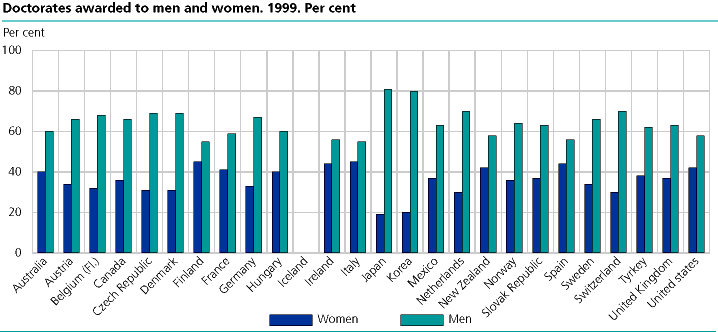Indicators on Education, in the OECD, 1998/99
High educational attainment in Norway
Published:
Norway has a high educational attainment compared to other OECD-countries. Approximately 85 percent of the population in Norway aged 25 to 64 years had at least completed an upper secondary education in 1999. The country mean across OECD was 62 per cent.
- Series archive
- Indicators on education in the OECD
Only the Czech Republic (86 per cent) and the United States (87 per cent) had a higher share of the population aged 25 to 64 years, with at least an education on the upper secondary level. Mexico, Portugal and Turkey had the smallest attainment rates on at least upper secondary education, respectively 20, 21 and 22 per cent. In Sweden, Finland, Denmark and Iceland the percentages were 77, 72, 80 and 56.
Within the age span 25-64 years the educational attainment is higher among the young people. 94 percent of the population in Norway aged 25-34 years had at least completed an upper secondary education in 1999. Among the population aged 55-64 years there were 68 per cent with an equivalent education. For this age group the OECD average was 45 per cent, while the United States was at the top with 81 per cent.
More remarkable differences at tertiary level
28 per cent of the population in Norway aged 25-64 years had completed an education at tertiary level in 1999. The country mean in OECD-countries was 22 per cent. Canada had the highest share at 39 per cent, while Turkey had the lowest share at 7 per cent.
A greater disparity between age groups is found at tertiary level. In 1999 33 per cent of the population in Norway aged 25 to 34 years had completed an education at tertiary level, and in the population aged 55 to 64 years 19 per cent had an education at this level. In ten OECD-countries there are twice as many aged 25 to 34 years with an education at tertiary level as there are in the group aged 55 to 64 years.
Highest educational attainment among women
In 1999 more women than men had completed a tertiary education in Norway. 28 per cent of the women and 27 per cent of the men aged 25 to 64 years had completed a tertiary education. In the group aged 25 to 44 years there are considerably more women who have attained a tertiary education. In the group aged 45 to 64 years the situation is reversed, as there are more men.
Overall, a higher proportion of women than of men hold a tertiary degree in 13 out of 29 OECD countries, all Nordic countries included.
Graduation rates for women at upper secondary education exceed those for men in most countries. In the majority of OECD countries, the gender ratio for upper secondary programmes designed to lead to further tertiary education strongly favours women.

Two-thirds to earn doctorates are men
Even though there are more women than men completing an education on upper secondary level and tertiary level, a majority of men are awarded with advanced tertiary degrees in Norway. 64 per cent of the advanced research degrees were awarded to men, which corresponds equally to the average in OECD. Men remain more likely than women to obtain advanced research qualifications in all OECD countries. Finland, Italy, Ireland and Spain have the largest share of women completing at this level, respectively 45, 45, 44 and 44 per cent. The lowest shares of women are found in Japan and South Korea with 19 and 20 per cent.
Participation in education
Participation in education tends to be high in Norway even beyond compulsory education. In 1999 86 per cent of the population aged 15 to 19 years were participating in education. The sharpest decline in participation occurs not at the end of compulsory education but at the end of upper secondary education. In Australia and the Nordic countries, one out of four 20 to 29-year-olds participates in education.
The statistics is a part of the annual publication Education at a Glance. The OECD is the publisher of Education at a Glance.
Tables
Contact
-
Geir Nygård
-
Statistics Norway's Information Centre
